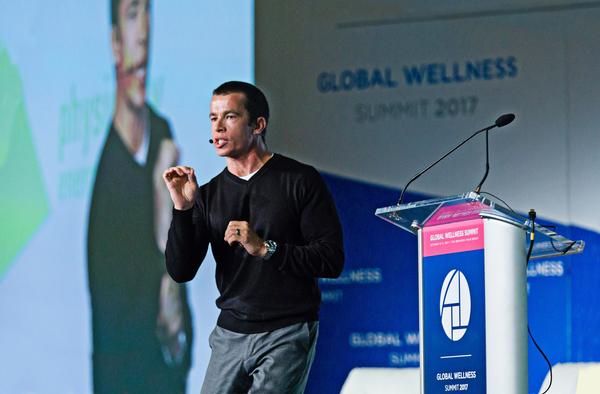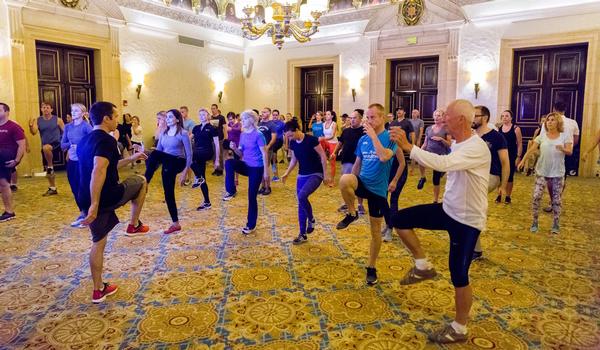features
Work place fitness: Fit to work
With UK productivity levels trailing behind other EU economies, Tom Walker asks if fitness offers a solution and if operators can use their knowledge to improve their own productivity

The UK is in the grip of a productivity puzzle. Figures from the Office for National Statistics (ONS) suggest that the nation’s output is so poor that the average German worker could go home on a Thursday afternoon, having produced as much as an average Brit who works the full week. In the time a British worker creates £1, a German one makes £1.35.
While the UK has lagged behind other developed nations in productivity levels since the 1980s, the 2008 banking crash seems to have hit Britain particularly hard. In 2007 – the year before the crisis – British productivity was 9 per cent below the average for the 35 OECD (Organisation for Economic Cooperation and Development) countries. By 2015, the gap had widened to 18 per cent.
THE PRESENTEEISM PROBLEM
Productivity issues often arise from challenges relating to strategy or logistics – challenges such as poor management practices, outdated systems and run-down equipment. While such problems can often be remedied through capital investment and training, these solutions are less effective when poor productivity arises from employee absenteeism – staff taking time off through illness – and presenteeism – turning up for work while sick or otherwise hindered.
However, the outcomes of an increasing number of wellness-focused initiatives now appear to suggest that fitness operators might be able to help tackle absenteeism and presenteeism.
Absenteeism is an issue faced by every business and one that can be monitored accurately. Analysis from the Centre for Economic and Business Research (CEBR) shows that workplace absence costs the UK economy around £18bn in lost productivity each year.
Presenteeism, however, is a lesser-recognised issue, and it’s one that often goes undetected by businesses. According to Hanna Leahy, wellness business development manager at Sheffield Hallam University (SHU), presenteeism is an even bigger killer of productivity than absenteeism.
“Presenteeism is estimated to cost somewhere from two to seven times as much as absenteeism, per person per year,” she says. “But it is near-impossible to observe or monitor.
“I liken it to an iceberg. Absenteeism sits at the top, where it's fully visible and easily measurable. But there’s a huge hidden cost just below the surface that can’t be seen or quantified.”
According to the Chartered Institute of Personnel and Development (CIPD), organisations are now becoming more aware of the problem, with an increasing number of UK companies taking steps to tackle the issue. In 2015, less than a third (31 per cent) of UK firms responding to a CIPD survey said they had taken action on presenteeism. By 2016, the figure had risen to nearly half (48 per cent).
However, while presenteeism might be hard to detect, it can also be alleviated – just like absenteeism – by improving employee wellness and health.
“All the underpinning science shows that productivity is related to health levels,” says Leahy. “By investing in employee health and wellbeing, employers will see a ROI in reduced absenteeism and presenteeism. The only question is to how to deliver the physical activities – as one size does not fit all and people’s needs and abilities are different.”
PERSONALISED APPROACH
For Leahy, the key to successful workplace wellness initiatives is providing individual plans that employees can commit to. This personalised approach is at the heart of SHU’s own in-house wellness programme, SHU Wellness.
The programme includes an hour-long, one-to-one, annual health check. There are a number of physiological and medical tests on offer – from measuring cholesterol and blood pressure to a fitness test – but nothing is compulsory. The results obtained from these tests are then used to develop wellness goals and an action plan for achieving them: from going to the gym to walking or swimming.
“We’ve been doing it for about 12 years at the university and do more than 1,000 appointments a year,” Leahy adds. “And it really does work. Our figures show that the initiative is achieving returns of around £4 to the £1, so it makes a lot of sense for employers.”
Indeed, the scheme has been such a success that the university has begun to deliver it for a number of external partners and companies looking to boost productivity – from NHS Trusts to retailers like Next. SHU has also partnered with healthcare provider Westfield Health, which is “selling” the programme on behalf of the university.
SPORTING PRINCIPLES
While getting staff more active seems to do wonders for productivity, could fitness and sport be harnessed to increase output levels in other ways? Colin Wilson, Commonwealth Games medalist and co-owner of The Business Athlete – a company helping business leaders and executives improve their performance – certainly thinks so.
“The Business Athlete helps organisations to improve productivity using methods from sports and other high-performance fields,” Wilson says.
“Our aim is to help companies create a high-performance culture, but also a high satisfaction culture. Our goals aren’t about achieving short-term, quick win, narrow successes, but more about achieving long-term, sustainable success.”
BESPOKE SOLUTIONS
Wilson explains how The Business Athlete has taken 35 aspects of performance – adopted from specific principles or from sport – and translated those into a corporate context. Each can be applied at an organisational, team or individual level.
He adds that as all companies and their productivity challenges are different, they all require bespoke solutions. “A general rule of thumb is to understand what you can, can’t, should and shouldn’t take from high-performance sport,” Wilson says.
“One of our principles at The Business Athlete is that each individual development plan within an organisation should be just that – individual – because everybody’s performance demand is different. A sports equivalent would be that you wouldn’t expect a striker like Harry Kane and a goalkeeper like Joe Hart to be doing the same training routine, even though they both play for England. Another principle that we use a lot is based on energy capacity and management. We want to encourage people to manage their energy levels and peak at the right moment.
“For example, you could have a personal trainer or gym instructor, all pumped up and waiting for a class to begin. They might use lots of energy to get everything ready – maybe even going through the exercises. By the time the class begins, their energy levels might be depleted. That’s one of the things we can learn from sport, managing your energy so that you peak at the right moment.”
BEHAVIOUR CHANGE
Whether tackling productivity through wellness or a high-performance-focused approach, Leahy and Wilson agree that success depends on behaviour change.
“Just providing access to a gym doesn’t mean it will get used, because the approach misses the crucial step of helping people to change their behaviour,” Leahy says. “And that’s the biggest challenge for employers, because changing our behaviour is really, really difficult.
“What we’ve seen that helps is a top-down buy in. If senior board level people say ‘we’ve put this on for you and we’re engaged in this’, it’s more likely to be seen as a carrot, not a stick. We worked with an NHS trust where the CEO was involved and promoting it, and the engagement was far better. It’s quite remarkable how it sends a message to the workforce.”
Wilson also underlines the importance of a focused, individual approach to help with engagement. “For a sports-related approach to work, you need to contextualise the methods to the company and its environment. You should start with the organisation or individual, then see how sport and the various sport principles could help. It’s not just about using sports psychology and expecting everyone to perform better. It’s about achieving results across the organisation, from top to bottom.”
Q&A with Chris Jordan
Director of exercise physiology, Johnson & Johnson Human Performance Institute (HPI)
The Corporate Athlete Performance (CAP) programme, which was developed by US-based Johnson & Johnson, takes techniques used in the development of top-level athletes and applies them to the corporate environment. Chris Jordan designed and implemented the movement and exercise components of the course, including the widely known 7-Minute Workout. An experienced international keynote speaker, author and performance coach, Jordan trains hundreds of corporate executives, including from Fortune 500 companies, every year.
Could you tell us about HPI and the CAP programme?
HPI was founded by Dr Jim Loehr, a sports/performance psychologist, and exercise physiologist Dr Jack Groppel. They initially combined forces to work on the minds and bodies of professional athletes to help them perform at the highest possible level.
They then developed the Corporate Athlete training programme, which teaches participants how to manage and increase their energy levels – physically, emotionally, mentally and spiritually – so that they can consistently perform at their best.
How does CAP work?
CAP integrates performance psychology, exercise physiology and nutrition in order to improve performance and productivity. The programme uses a number of principles:
1. Manage your energy
Make the most of the limited time you have by bringing your best energy and being fully engaged in the moment
2. Energy is four-dimensional
The programme states that there are four dimensions of energy (physical, emotional, mental and spiritual). Each of them can influence the others
3. Oscillation/Recovery
Energy expenditure must be balanced with energy recovery. This can be achieved is by incorporating short periods of energy recovery throughout the working day
4. Stress for success
Stress provides the opportunity for growth. Too much stress and too little stress can both cause a decrease in capacity and performance








































































